Ask the Expert Articles
Regional Community Health Team Initiative: the Wisconsin Model
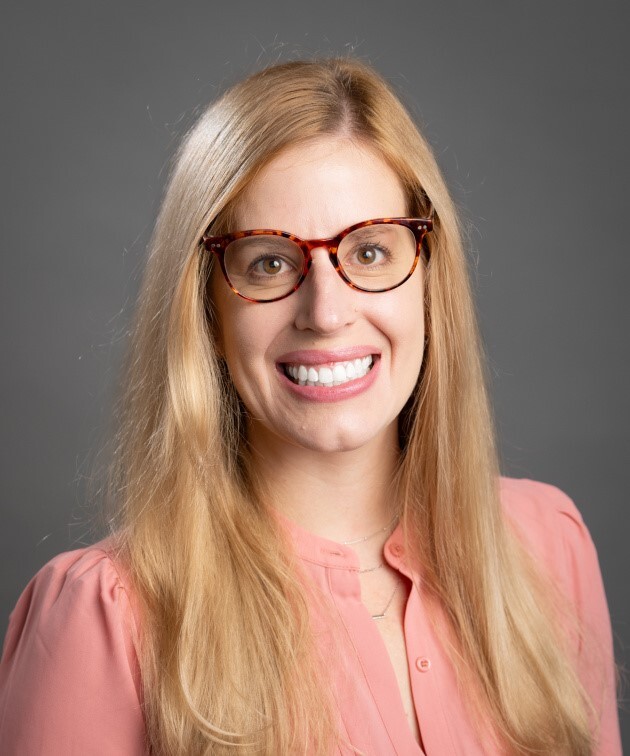
Sarah Boulton, LCSW
Regional Community Health Team Supervisor, Institute for Health & Well-Being, University of Wisconsin-Madison Division of Extension
The Regional Community Health Team (RCHT) is a new initiative within University of Wisconsin – Madison Division of Extension’s Institute of Health & Well-Being (HWB). The RCHT provides training, technical assistance, and resource support to build capacity of community-based partners in identifying and responding to community driven health priorities.
The RCHT provides technical assistance and capacity building to local and Tribal health departments, coalitions, and community-based organizations in support of community health assessment and planning processes. This includes support for partners in:
- Authentically engaging community in community health assessment, planning, and decision-making processes.
- Enhancing community health assessment activities.
- Moving from data to action using evidence-based strategies and policy, systems, and environmental approaches.
The RCHT works in partnership and alignment with Extension county-based staff and specialists, while extending the reach and capacity of HWB around the state to advance community health.
Meet the Wisconsin Regional Community Health Team:
- Sarah Boulton Regional Community Health Team, Supervisor.
- Pearly Wong Regional Community Health Coordinator, Northeast Region
- Sheena Cook-Fuglsang Regional Community Health Coordinator, Southwest Region.
- Selena Freimark Regional Community Health Coordinator, Northwest Region.
An example of our recent work:
The RCHT recently partnered with HWB’s Health Equity State Specialist, Jen Braun to pilot Deliberative Inquiry as part of the Community Health Improvement Plan process for Wood County Health Department. Deliberative Inquiry is a highly structured way in which to engage community in dialogue around complex community issues. HWB is piloting the use of Deliberative Inquiry in the Community Health Assessment (CHA) and Community Health Improvement Plan (CHIP) processes. Community conversations were held November 7th and November 14th in Wood County. Conversations were co-facilitated by Extension staff, including Sheila Michels, Health & Well-Being Extension Educator in Adams County, Michelle Van Krey, Healthy Communities Coordinator, and RCH team members Pearly Wong, Sarah Boulton, and Sheena Cook-Fuglsang. Community conversations helped identify what strategies have community support, or do not have support, related to financial well-being, substance use, and mental health in the county.
Article provided by Sarah Boulton, January 2025 newsletter, Great Lakes ROTA-RC Reporter
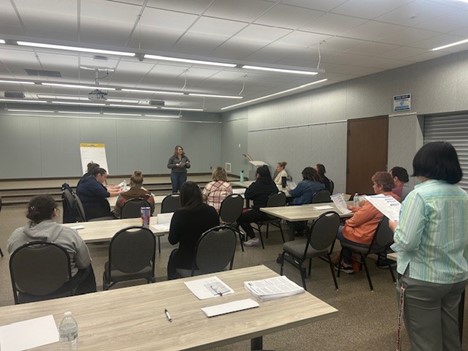
Deliberative Inquiry team in Wood County, Wisconsin
Child and Family Traumatic Stress Intervention

Ashley karimi, MSW, LISW-S
Child and Family Trauma Stress Intervention Lead and Southeast Ohio Child Abuse and Neglect Prevention Coordinator
According to the Substance Abuse and Mental Health Administration (SAMSHA) by age 16 at least two thirds of children will report at least one traumatic event. Potential traumatic events might include things like discrimination due to race, gender, or sexual identity, the death of a loved one, physical or sexual abuse, community violence, or a serious accident.
Since trauma is based on an individual or group’s experience of harm- it is best to center each person or community’s understanding of what has happened rather than assuming an event is traumatic. As adult helpers, it can be useful to take a step back and allow the child to use their voice or other forms of expression to describe how the trauma has impacted them. In children this is often seen through their behavior such as traumatic themes in play, nightmares, changes in eating or sleep, or troubles with concentration.
What can be particularly difficult when helping children who have experienced trauma, is that children sometimes minimize things out of fear or being overwhelmed.
- A child may not want to talk about their abuse due to real or perceived threats.
- There may be concerns about separation from family members or other changes.
- The child may appear “okay” so that they don’t seem different from their peers or to make others in their life feel better.
- The child may have difficulty with identifying or regulating their own emotions about the trauma.
Caregivers can also be uncertain about what to do in these situations or have their own trauma history which is being activated by what their child is going through. Yet, having support from family, friends, or other community members lets a child know that it is okay to talk about their trauma which can help with healing.
The Child and Family Traumatic Stress Intervention (CFTSI) is a mental health treatment provided during the first 30-45 days after a child has experienced a traumatic event or has shared about a past trauma. This form of treatment typically takes five to eight therapy sessions for children ages 7 to 18 years old and has been proven to reduce trauma reactions in children, in addition to reducing or interrupting the development of post-traumatic stress disorder.
CFTSI focuses on increasing family communication and support to reduce trauma responses through identification of trauma symptoms and reminders, as well as developing needed coping skills. In one-on-one sessions, caregivers can reflect on their own trauma reactions and explore resource needs for their family during a time of intense stress. CFTSI also serves as a form of extended assessment, so that the provider can collaborate with the family on what type of follow-up services are needed after completion of the model. Since this intervention is brief, more children are able to receive evidenced based trauma treatment. Many families can be seen quickly, which in turn reduces waitlist times, and for some families CFTSI may even reduce their need for any long term services.
There is hope that things can get better after trauma, particularly when a child is surrounded by supportive relationships and community in a safe environment. Research has shown that positive childhood experiences can serve as a protective factor to increase well being into adulthood. Positive childhood experiences can be things like bonding with safe adults, gaining a sense of belonging through activities like volunteering or mentoring, having equitable access to resources like quality nutrition, education, and housing as well as unstructured play with peers.
As a society, there is a collective responsibility for each of us to advocate for policies that support child and family well being. Continuing to find ways to support diverse communities through prevention and early intervention efforts ensures equitable access to resources and care to combat both historical and present-day trauma. I want to express gratitude to each of you who are doing your part to create safe, supportive communities through your work and commitment to prevention. Feel free to reach out to me if there are any ways I can support your work.
Article provided by Ashley Karimi, June newsletter, Great Lakes ROTA-RC Reporter
Reference List
Help is On the Way
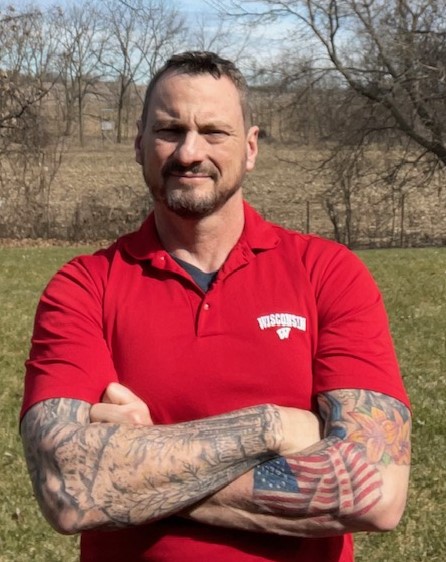
MIKE BLASER, MS, OCLPM
Direct Education Consultant, Great Lakes ROTA-RC
Most of us have our self-care routines or ways we look to unwind. Music can be an important part of managing stress. I listen to everything from classical music, hair bands from the late eighties, and offshoots in between. We look for music to motivate, entertain, and even inspire us. One of my morning workout songs is by the band Rise Against, and the title “Help is on the Way.”
I was part way through my draft authoring this article when the lyrics struck me:
Help is on the way
(They said, they said)
Help is on the way
(They said, they said)
We were told just to sit tight
Cause somebody will soon arrive
Help is on the way
But it never came
It never came
“Help is on the Way” by Rise Against, written by Tim McIlrath
I have seen the music video and listened to this song countless times. As I listened, I started to think and wonder if this is the dichotomy of how our veterans, and first responders feel. While they serve, they are the “help that is on the way.” While I served in law enforcement for twenty-five and half years, I contemplated this dichotomy every time I got a S.W.A.T. call out, “help is on the way.”
I recently retired after spending the previous decade serving in the capacity of crisis intervention. I understand the stigma attached to police work and getting mental health services. I have heard first responders and veteran groups demonstrate and express similar struggles. I have considered the following questions, and I pose them for you to consider: What happens when the helpers are done helping? How do we help those in harm reduction, first response, and veterans to recover from and know that “help is on the way” for them?
Day by day we see political challenges, staffing shortages, economic uncertainty. On top of the media’s overwhelmingly negative coverage of key issues there is a history of scars and stigma for those who served. So, let us talk briefly about stigma.
Merriam-Webster provides four definitions for the word stigma. The first three are as follows: 1. “a set of negative and unfair beliefs that a society or group of people have about something”; 2. “a mark of shame or discredit”; 3. “a small spot, scar, or opening on a plant or animal.”
Injury is a trauma, a small opening to a vulnerability. These injuries or traumas provide experiences for us to learn and grow if we are in a supportive environment to manage the vulnerability safely and heal.
For society’s helpers, like our veterans, those environments either do not exist, or they lack consistent access to the resources needed to allow them to heal fully. Trauma recovery requires time, attention, and commitment to heal just like physical injuries. We must ask where our veterans and first responders can go to receive services for mental health related issues. Are the services easy to find?
At a time when the public mental health crisis is at its highest, there is no better time than the present to give non-traditional/non-clinical services a try. There are volunteer organizations and nonprofits that can help. Organizations like SAMHSA, NAMI and Lutheran Social Services are just a few examples which can be of significant help.
Let me state very clearly: non-traditional services do not replace therapy when therapy is indicated. Non-traditional services provide non-clinical services and support individuals in learning coping skills that can decrease stress and increase positive health as well as serve as an early recognition of signs and symptoms for mental health concerns.
The Great Lakes ROTA-RC, and its partnership with the cooperative extension offices in Illinois, Indiana, Michigan, Minnesota, Ohio, and Wisconsin is connected to a multitude of evidence-based, education resources and materials that can help you, your community, and your partnerships advocate to end the stigma for your local helpers. What better way to help those who helped others than to create space for services and support that put their health and well-being at the top of the priority list. Right now, the Wisconsin ROTA-RC partner, UW-Madison, Division of Extension, is supporting both direct and virtual education in two key programs, Mental Health First Aid (MHFA) and WeCOPE (Connecting Our Positive Emotions).
Learning to instruct these two courses has been of great benefit to me personally. The desire to serve is innate for most who work in public service. It does not go away with retirement. Instructing these two courses is my way of continuing to serve. Both courses have offered me tools to apply to my personal life as I transition into retirement as well. Having experienced the benefits firsthand from these programs, I am dedicated to serving other helper communities, like our veterans and first responders.
Article provided by Mike Blaser, April newsletter, Great Lakes ROTA-RC Reporter
If you are in a Wisconsin county and would like more information about direct education for Military, Veterans, and their families and/or First Responders regarding WeCOPE and Mental Health First Aid (MHFA) programming, please contact the Technical Center’s email
Let’s Talk About Mental Health

AUTHORS & EDITORS
Tessa Garrow and Stephanie Woodcox,
Purdue Extension
Health & Human Sciences,
Purdue University
Andrew Airey,
Lindsey Daoust,
Jaime Escobedo,
Jimmy Hamrick,
Nate Payton,
Kira Siepman,
Julie Smith,
Jenn Whitney,
School of Nursing,
Purdue University
National conversations about health are no longer limited to a person’s physical well-being. Today, conversations recognize the importance of balancing physical and mental health needs. As we continue to talk about mental health more openly, it is helpful to understand what “mental health” means. Mental health includes a person’s thoughts, emotions, and how they experience the world around them. When a person’s mental health negatively affects their functioning, their symptoms can indicate the presence of a mental health disorder.
Estimates suggest that 21% of adults in the United States experience a mental health issue in a given year, meaning around 50 million people experience mental health struggles annually. However, only 41% of those adults receive professional mental health care annually.
This means fewer than half of all individuals living with a diagnosable mental health condition actually access treatment.
Many people do not seek mental health treatment because of negative attitudes and assumptions about mental health, also known as stigma. Stigma can particularly influence whether members of marginalized groups, young people, men, military professionals, and health professionals seek treatment. Stigma contributes to inaccurate perceptions that mental health struggles indicate mental weakness and permanent dysfunction. With proper resources and support, people can manage mental health issues and improve their symptoms. Increased understanding about mental health can help lessen fears and stigma. Reducing stigma makes people more likely to seek support and proper care.
In the same way a person can develop habits to maintain their physical health, they can also develop habits to maintain their mental health. Engaging in regular self-care, maintaining self-awareness about one’s emotions, and fostering supportive relationships all benefit someone’s mental health. These habits can help someone shift away from using harmful coping behaviors. Mental health disorders appear differently in people, but symptoms typically improve with professional treatment. Importantly, mental health treatments must be customized to the individual to be most effective.
View the full resource below; download and share with partners.
Article provided by Tessa Garrow, February newsletter, Great Lakes ROTA-RC Reporter
Strengthening Families, Supporting Parents: Encouraging Protective Factors Through In-Home Education
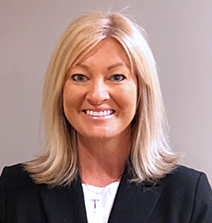
heather reister, MS
Educator, Family and Consumer Sciences, Butler County, for The Ohio State University College of Food, Agricultural & Environmental Sciences
The Development of Living Skills (DLS) program, housed within the Family and Consumer Sciences division of Ohio State University Extension, has been collaborating with parents in Butler County for over 35 years. Via the program’s long standing relationship with the Ohio Department of Job & Family Services, the DLS program receives client referrals from child services workers in the county. In the case of many of these referrals, the children have been removed from their home due to allegations of abuse and neglect or are at high risk of being removed.
The DLS program has four pillars: parenting, health and wellness, home and safety, and resource management. With these four pillars as a guide, DLS educators develop lessons to strengthen protective factors in parents’ lives and build up life skills they had not previously been taught. These lessons are personalized to the client’s goals, developed in consultation with their child services worker. At the core of the lessons is the concept of Active Parenting coupled with hands-on learning. Some of the tools DLS educators use include Positive Parenting Program strategies, USDA MyPlate, CDC Parenting curriculum, and other cooperative Extension models.
DLS educators also prepare hands-on to-go kits to take to participants’ homes, covering topics including but not limited to mindfulness, finances, and stress management. Hands-on activities facilitated by DLS educators include role-playing different skills, assigned reading, and other knowledge application activities. Program recipients are typically enrolled in the program for six to eight months before successful completion. Ultimately, the goal of the program is to be an educational support for parents to support family unification, not a therapeutic intervention. Annual reports on the DLS program indicate around $100,000 a year return on investment when reviewing the cost of supporting a child in foster care versus the cost of investing in family reunification. To learn more about the DLS program, visit their website, butler.osu.edu .
Article provided by Heather Reister, February newsletter, Great Lakes ROTA-RC Reporter
Illinois Statewide Recovery Oriented System of Care (ROSC) Councils

Mark Sanders, LCSW, CADC
Project Manager Illinois for Great Lakes Addiction Technology Transfer Center (ATTC),
“The concept of Recovery Oriented System of Care (ROSC) Councils is encapsulated in the African proverb, “If spiderwebs are united, they can carry a lion.” This unity mobilizes entire communities to reduce overdoses and increase recovery rates.”
Mark is the author of five books on behavioral health recovery. Recent writings include Slipping Through the Cracks: Intervention Strategies For Clients With Multiple Addictions Disorders and Relationship Detox: A Counselors Guide To Helping Clients Develop Healthy Relationships In Recovery. He was lead writer on a trauma informed gun violence prevention curriculum which is being implemented in several large cities in the United States. His groundbreaking monograph Recovery Management co-authored with historians William White and Earnest Kurtz helped shift substance use disorders treatment and recovery from the acute care model solely towards a Recovery Oriented System of Care. Mark has had two stories published in the New York Times bestselling book series, Chicken Soup for The Soul.
Mark has also had a 30-year career as a university educator having taught at The University of Chicago, Loyola University of Chicago and Illinois State University Schools of Social Work. He is co-founder of Serenity Academy Chicago, a program which sponsors recovery-oriented peer groups in local high schools.
Here, Mark provides insights on the Illinois statewide effort to build Recovery Oriented System of Care (ROSC) Councils.
What is the underlying concept behind the Illinois Statewide ROSC project?
“The concept of Recovery Oriented System of Care (ROSC) Councils is encapsulated in the African proverb, “If spiderwebs are united, they can carry a lion.” This unity mobilizes entire communities to reduce overdoses and increase recovery rates.
The ROSC Council statewide initiative began with support from the Illinois Department of Human Services and the Division of Substance Use Prevention & Recovery. The goal of the statewide effort is to build communities that support and nurture recovery. The Great Lakes ATTC also provided intensive technical assistance for implementation. The first Illinois ROSC Councils originated in the Chicago area, but have expanded to rural areas, particularly in the southern part of the state. Overall, the Illinois ROSC Councils are having a transformative impact, with councils now established in 52 of the state’s 102 counties.”
Read Mark’s related article: A Recovery Revolution in Illinois
Who is typically involved in a ROSC Council?
“Each council has a lead organization that is supported by IDHS/SUPR. Involving people with lived experiences and those in recovery is key in the ROSC Councils. The councils bring together diverse individuals from the community, including representatives from social services, faith-based organizations, hospitals, employers, families, librarians, law enforcement, and individuals from justice systems. Employers also play a crucial role, as studies show that hiring individuals in recovery reduces overdose rates and recidivism.
Including law enforcement has been effective in reducing incarceration, increasing treatment rates for people who have drug-related offenses, and reducing stigma. Including medical professionals who work in hospital emergency departments has also been key to getting people into treatment as soon as possible after an overdose or other substance use related medical emergency. Bringing in librarians has been a way to engage with people who are homeless, who often seek shelter in public libraries.”
What are unique aspects of ROSC Councils in small towns and rural areas?
“ROSC Councils in rural areas have been able to quickly set up supports that can be harder to arrange in metropolitan areas, such as engaging local transit authorities to provide individuals in recovery with transportation to treatment and employment.”
How could other states replicate the Illinois ROSC Council model?
“The project started small in the first year and a great deal of learning occurred. In the beginning, eight providers selected to develop one ROSC Council in the county they served. Each provider worked with a coach who helped them develop the council. The providers participated in a monthly collaborative call where they learned from each other how to mobilize a community to work together to promote recovery. Each year more providers were added – leading to the 52 ROSC Councils we have today.”
For more information on the Illinois Statewide ROSC Initiative, contact
Michael Deschamps
Administrator of Infrastructure, Planning and Development,
Illinois Department of Human Services: michael.deschamps@illinois.gov.
Nadia Klekamp
Director of Integrated Community Education
Chestnut Health Systems: nfklekamp@chestnut.org
Learn more at the upcoming Great Lakes ROTA-RC training:
Recovery Oriented Systems of Care
January 31, 2024
Article provided by Mark Sanders, January newsletter, Great Lakes ROTA-RC Reporter
Nutrition as Harm Reduction
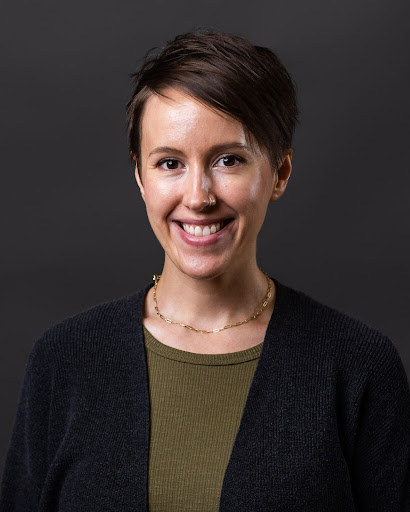
SUSIE WEST, MPH
Health & Nutrition Extension Educator, Department of Family, Health and Wellbeing, University of Minnesota Extension
Nutrition can play a really key role in harm reduction for those actively using substances and for those who are in recovery. For those who are using substances, access to food in general, let alone nutritious options, may be limited or not a priority. Consistent food access could help counter the effects of the substances or behaviors associated with substance use that could negatively impact their health. For those in recovery, being appropriately nourished could help reduce the likelihood of recurrence of use and keep them on track for long term recovery. Nutrition in recovery stages is also essential for rebuilding brain, gut and immune health that may have been impacted by previous substance use.
Substances, like food, influence all of our bodily systems so I see nutrition as a really powerful tool in supporting the whole-person healing of folks with SUD. Food has the ability to reconnect us with others, with our sense of self, with our culture, and our community which has benefits beyond just the nutrient content of what we’re eating. Nutrition as harm reduction certainly entails focusing on nutrient-dense food but we can’t overlook the healing that people get from cooking a family recipe, enjoying a treat or the sense of self-efficacy that comes from making health-supporting decisions on their own.
I would encourage them to become familiar with food access in their communities, learn about the food shelves in your area, the farmers’ market, mobile markets or mobile food shelves, community gardens and other resources. If we want folks to eat nutritious food, they’ve got to have access to it! I would also encourage them to consider framing nutrition as flexible when talking to their clients. I think so many people get turned off from healthy eating because it can be too rigid or dichotomous–it really isn’t! Celebrate small victories with nutrition like adding fruit as a snack or picking a side salad instead of fries. Practitioners may also look into what nutrition education is available for their clients in their communities, like SNAP-Ed or EFNEP community classes! These can help provide practical tips for meal planning, nutrition and cooking skills, often at no cost.
Article provided by Susie West, October newsletter, Great Lakes ROTA-RC Reporter
Sources of Strength – Ohio’s Approach to Youth Mental Health

AMANDA CONN STARNER, MS, CHES, OCPS
Chief Program Officer, PreventionFIRST!
At a time when mental health wellness for our youth remains front and center, we invite you to consider the Sources of Strength curriculum to aid your school or community’s efforts to improve the mental well-being of kids and reduce youth suicide rates.
Sources is an evidence-based, upstream prevention program that employs a strength-based approach to improving the health and wellbeing of individuals. Implemented in schools and communities, this program works to give students tools to develop their strength, resilience, and help-seeking behaviors. The primary mission of Sources is to move further upstream in the prevention cycle.
A few of the components of the elementary curriculum include Talking Circles, Active Learning Activities, Calming Activities and Guided Reflection. In addition, Celebrations of Growth are an integral part providing opportunities for students and staff to apply and celebrate a growth mindset, while Everyday Application and Extension activities allow students to practice their new skills and provide touch points for instructors and classroom teachers to integrate the concepts being learned in the classroom.
Some key steps in the secondary program include utilizing connected adult advisors and student peer leaders to enhance protective factors associated with reducing suicide through strategic messaging campaigns. Using a peer led model, students are empowered to leverage their social influence as agents of change in their school.
Other structure elements of the curriculum are:
· The program is available K-12 but does not have to be implemented at every grade level.
· The cost of training and implementation is currently covered by grant funding. There is no cost for implementation.
· The secondary program is listed as an approved program for the SAVE Students Act.
To learn more about registering for the program, visit sourcesofstrength.org. You can also reach out to PreventionFIRST! Project Consultant, Julie Cameron at julie@prevention-first.org or Kelly Roberson of Sources of Strength Ohio kroberson@prevention-first.org.
Article provided by Amanda Conn Starner, September newsletter, Great Lakes ROTA-RC Reporter
Three Steps to Restore Your Humanity

MIKE BLASER, MS, OCLPM
Mercyhealth System Trauma Preparedness Center
During the past 25 years, I saw my share of sad, bad, and traumatic. Don’t get me wrong it wasn’t all doom and gloom. There were plenty of silly, funny, and you just can’t make this stuff up incidents. Like the night an intoxicated person looked at me with a huge grin and said, “what’s wrong with your nose.” Those who know me would understand. I hope as my retirement looms, I remember the latter more than the prior. Over these years I experienced depression and a loss of humanity.
The definition of a first responder has expanded beyond that of the traditional public safety role. We now understand this to include police officers, paramedics, EMT’s, firefighters, nurses, doctors, counselors, dispatchers, social workers, and probably many more that I may have overlooked. Every one of these jobs requires that you experience trauma and vicarious trauma, much as our clerical staff do every day as they type reports.
Recently there has been an ongoing conversation around the country regarding mental health and the wellness of those serving as first responders. This is because suicide is taking the lives of first responders more often than being killed in the line of duty. For example, EMS providers are 1.39 times more likely to die by suicide than the public. [1] Studies have found that between 17% and 24% of public safety telecommunicators have symptoms of post-traumatic stress disorder (PTSD) and 24% have symptoms of depression[2]. Between 2007 and 2018, nurses were 18 percent more likely to die from suicide than the general population.[3]
This constant reaction to trauma causes a numbing of the senses. This numbness that all responders feel is often joked about, and eventually turns in to a loss of humanity.
When you see trauma, you know the sad, the bad, and the awful. You become jaded, numb, and are forced to stop feeling. If you felt it all, as you eventually will, it becomes overwhelming. Seeing these events are not what solely drives depression. It’s not what drives the feeling of darkness and bitterness. It’s the loss of humanity that causes so much grief.
It’s when you recognize that you lost your own humanity that depression really sets in. Your focus on the icky bad awful day took away the spirit you had when you applied for the job. Do you remember, during the interview for this job, you answered a question with the following phrase, “Because I want to help people.” What happened to that feeling? Now you’ve reached a point where you do the job everyday, but without emotion or feeling. You begin to feel robotic and one day you wake up and think your humanity has been stripped from you. Without humanity, how can one serve humanely?
There are three tools I focus on when restoring humanity to my role and my job. By focusing on these three tools, you can restore your own humanity, as well as serve humanely; driving better connections and a happier work life.
1.) Serve with empathy, 2.) Perspective seeking; seek to understand, 3.) Treat the trauma
Empathy is a difficult tool for many first responders. It is also the first skill we tend to lose. First responders are problem solvers and look for solutions. Sometimes a solution is not needed, your presence is needed more than a solution. Empathy is very different than sympathy. Sympathy is a lack of understanding and places judgement, whereas empathy is supportive. For many first responders it’s hard to be supportive and empathetic when you have your own challenges to face during your effort to solve problems for others.
Empathic conversations take effort and practice. I cannot tell you to “be empathetic.” I encourage you, when you hear a problem, reflect to that person how you understand the frustration, or how sad this must be. Tell them you can’t know how they feel, and you are there to help. Ask them what they need, not what you can provide. Practice listening to what the root of the problem is, not focusing on what your solution will be. Empathic listening helps people feel understood and cared for, even for a minute. Empathy is the first step to restoring your humanity by showing humanity to others.
One of the things I heard in police work for years is, “they had it coming, or they chose this.” This is one of the greatest indicators of a loss of humanity and brings me to the second tool, perspective seeking. It is easy to assume an outcome when you have no idea what precipitated the event. This is also the epitome of judgement and stereotyping.
Taking a few minutes to listen to a story, not just the words but what the environment around that story tells you. Your other senses can help you understand the perspective of the person and the problem you are asked to solve. The smells, the sounds, the appearance of the person and the environment, and the non-verbal cues that you are receiving. As an example, speaking to a person that smells unbathed may be unpleasant. Think for a second how embarrassing it must be for the person who is unbathed. What situations precipitated today that didn’t allow them to bath for a lengthy period? What else could be contributing to today’s situation?
For the perspective taking tool, your goal is to ask yourself questions and be mindful of what could be the answer. Also notice that I said the person and the problem. After years in a role serving people, the person can become the problem for you. If you take just a few moments to think introspectively you may find that the situation is different than you judged it on first appearance. This tool also takes practice. The more you use it, you will find your connection to people will improve and you will be closer to restoring your own humanity through connection.
[1] https://blogs.cdc.gov/niosh-science-blog/2021/04/06/suicides-first-responders/, [2] [author to provide resource upon request], [3] https://www.ncbi.nlm.nih.gov/pmc/articles/PMC8344804/
Article provided by Mike Blaser, August newsletter, Great Lakes ROTA-RC Reporter
Rural Mental Health & Suicide Prevention Projects in Rural WI Communities
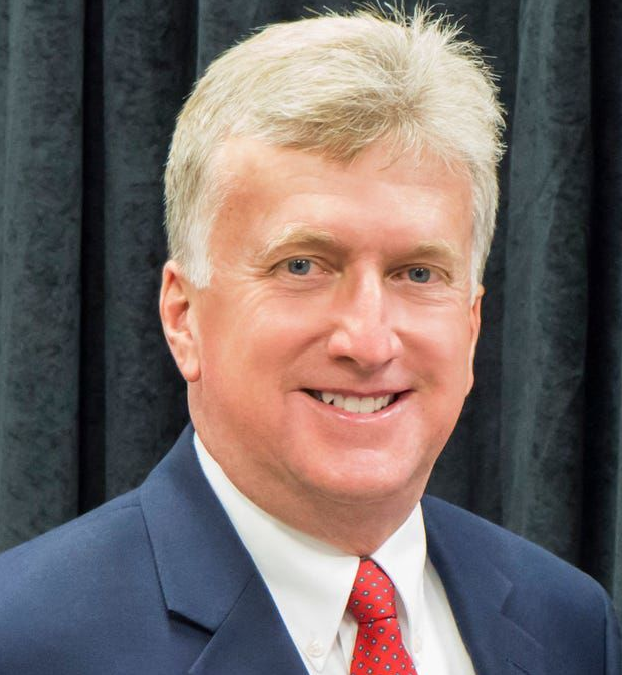
JOHN SHUTSKE, PhD
Professor and Agricultural Safety & Health Specialist
Rural mental health, suicide prevention, and well-being programs abound in Wisconsin thanks to partnerships and coordination efforts that have been led from the University of Wisconsin (UW) through Extension, agriculture, and other units.
The “Resilient Farms and Families” (RFF) project first took shape in 2018, led by Extension specialists Joy Kirkpatrick and John Shutske who both work in agriculture. RFF began by creating a web-based resource center and coordinating activities and check-ins for a statewide cohort of partners. These included the state’s agriculture department and many rural-serving organizations. Much of the success of RFF was to create new relationships and to help connect the dots through numerous communication channels.
As we entered the pandemic, the issue of farm stress became a priority for several funding organizations. Wisconsin took a major leadership role on issues of economic stress as a partner on the USDA-funded North Central Farm and Ranch Stress Assistance Center – a 12 state effort headquartered at the University of Illinois. Also in 2020, the Wisconsin Partnership Program (WPP) allocated funding to the Southwest Community Action Program (SW-CAP) and UW, creating the Farm Well Wisconsin program, a project that partners with farmers and community members to develop that support the health and wellbeing of farmers, farmworkers, and their families.
A final highlight was the adaptation of the WeCOPE curriculum specifically for those in rural and agricultural communities. WeCOPE is based on the idea of Connecting with Our Positive Emotions. It focuses on 11 specific skills that are easily learned and practiced. The WeCOPE skills are directly tied to the work of Dr. Judy Moskowitz at Northwestern University. The program is designed to be delivered over seven weekly sessions, though the rural version has been delivered in 90-minute sessions that showcase a handful of tools in the WeCOPE toolbox based on the interests and desires of different groups.
Article provided by John Shutske, August newsletter, Great Lakes ROTA-RC Reporter
Taking Action Against Substance Use in Communities (TASC)

Assistant Dean and Program Leader, Community and Economic Development, University of Illinois Extension
Taking Action to Address Substance Use in Communities has been developed by a team of health professionals and Extension professionals from Purdue University, the University of Illinois at Urbana-Champaign, and The Ohio State University to provide a theoretical framework for Extension professionals as they work with communities to create a collaborative approach to addressing substance use disorder. The waning and irregular access to treatment providers in rural areas, combined with a need to increase efforts to help individuals with SUD enter recovery, call for community-based approaches which increase collaboration among community organizations and individuals involved with substance use prevention, treatment, and recovery support.
The program was designed for communities which may not be using all their resources, have a shortage of treatment providers, experience significant barriers to recovery, or who wish to take a more proactive stance on substance use and develop an effective community-based intervention to augment and collaborate with existing recovery resources. Working with a facilitator, community coalitions create a map of their communities, identifying the gaps and barriers, along with the resources, that make up the community response to substance use. Using the map, the coalition members identify priority areas for projects, and then develop action plans to address those priority areas.
To learn more about how this program was implemented, join the webinar on August 24, 2023, hosted by the North Central Regional Center for Rural Development. The webinar will describe the experience of the Turtle Mountain Band of Chippewa Indians as they worked to create a recovery-oriented system of care to serve their tribe. To see program materials, visit the Community Development Extension Library.
Article provided by Anne Silvas, July newsletter, Great Lakes ROTA-RC Reporter
What is Indiana Recovery Network?
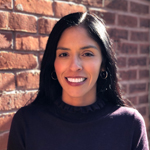
HEATHER RODRIGUEZ, MSW, CAPRC II
Vice President of Recovery Advocacy and Programs & Director, Indiana Recovery Network
Heather Rodriguez began her career in 2018 as a student intern with Mental Health America-Indiana while pursuing her undergraduate degree in social work. Her first assignment was to work on creating Indiana Recovery Community Organizations (RCOs). Her internship led to permanent positions and her current role as Vice President of Recovery Advocacy and Programs and Director of the Indiana Recovery Network (IRN). “This was all possible due to my sustained recovery,” says Heather. She recently celebrated 16 years of recovery.
“Often people new to recovery don’t know where to start when they’re seeking help,” says Heather Rodriquez, Director of Indiana Recovery Network. “We created a website to make it easier for people seeking recovery support in Indiana to find out what resources were available.” The website includes a search function that people can use to look up resources by city or zip code to find organizations and service providers nearby.
The Indiana Recovery Network was created through a SAMHSA grant awarded to the Indiana Addictions Issues Coalition (IAIC), a program of Mental Health America Indiana, in 2017 to build a statewide network for Recovery Community Organizations (RCOs).
“IRN now includes more than 100 recovery-focused member organizations that provide wide a variety of services, including training on recovery services, recovery residences, RCOs, and recovery engagement centers,” says Heather. SAMHSA’s four dimensions of recovery provide the guiding framework for IRN: health, home, purpose, and community.
“We continually update the website with new resources as we believe that recovery support is sustained when all the dimensions are covered,” adds Heather. “People can go to our events page to see what member organization are doing through free trainings, group services, or fun pro-social events around the state,” she explains.
Recent updates include information on grant opportunities for RCOs and Medicaid changes affecting people who may lose coverage that was extended due to COVID-19. “We also offer trainings available at no cost with support from our partner at the state Division of Mental Health and Addiction.”
Another exciting development is the RCO certification program that the IRN launched in October 2022 in partnership with the DMHA Recovery Works Program. “We are now up to 11 certified RCOs in Indiana,” says Heather.
Article provided by Heather Rodriquez, June newsletter, Great Lakes ROTA-RC Reporter
How Does Trauma Connect to Substance Use and How Can Healing Start?
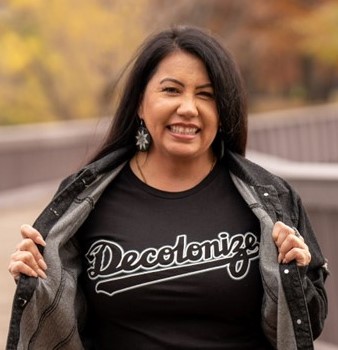
BRIANA MATRIOUS, Tribal Community Facilitator
University of Minnesota Extension Educator and Extension’s American Indian Resource Resilience Team
I believe that addiction is just a symptom of historical trauma. Until we get to the root cause of our pain, we won’t ever figure out the opioid crisis, we will never figure out alcoholism or any other symptom of trauma for that matter. I believe we have to get to the root cause of our issues. When we start to heal, we heal the generations before us and we heal the generations [to come]. For many families, there have been multiple generations that have been forced to be in boarding school. When we understand the impact of historical trauma like boarding school, then we understand the intergenerational trauma that happens and why those cycles continue. We start to understand the correlation between trauma and addictions, and how we cope with the pain of it all. I also think that it’s important that we talk about forgiveness and healing and what it means to us so we can understand where we need to go on our healing path.
Article provided by Briana Matrious, April Newsletter, Great Lakes ROTA-RC Reporter
What is the Importance of Providing Fentanyl Test Strip Education to Youth?

DR. BETH WEINSTOCK, founder of BirdieLght
We’ve reached a cultural pivot point; in 2021 alone, we lost over 108,000 lives due to a drug-related fatality, and that’s the highest number ever recorded on American soil. The overwhelming majority of these deaths are due to fentanyl. Young people today are sadly part of the ‘fentanyl generation’; the fastest rising age demographic for these fentanyl-related fatalities is age 15-25, as well as in communities of color. When BirdieLight speaks to young people at high schools and colleges across the country, we stress to them that, unfortunately, this IS the greatest public health crisis of their generation.
And this rapid escalation of fatalities has hit every corner of American life. From the student who tries a presumed Adderall, to the young professional who tries a line of cocaine, to the teen who takes Xanax (which isn’t ‘Xanax’ at all, but rather a counterfeit pill pressed with fentanyl), our young people are dying.
To that end, we must equip them with knowledge and tools. Once we deliver the fentanyl facts to a young person, our hope is that they will never try a pill or powder, but we realistically can’t keep all young people from ever experimenting with substances. Fentanyl test strips, a powerful tool in the fight to keep young people alive, allows the user to test a pill or powder for the presence of fentanyl, so that an informed decision can be made before ingestion. Fentanyl education and these test strips—up to 96% sensitive at detecting fentanyl in any pill or powder—empower youth to get as close to safe as possible. And as we all know, an empowered and educated generation is the first step toward a solution to this public health crisis.
Article provided by Dr. Beth Weinstock, March Newsletter, Great Lakes ROTA-RC Reporter
Great Lakes ROTA-RC Specialist Profiles
Ashley Karimi, MSW, LISW-S Child and Family Trauma Stress Intervention Lead and Southeast Ohio Child Abuse and Neglect Prevention Coordinator.
Heather Reister, joined The Ohio State University College of Food, Agricultural & Environmental Sciences, with a Master’s degree in Family & Child Studies. Heather has over 25 years of experience working with families in her areas of specialization which include early
childhood, family systems, and life skills development. Acknowledging early intervention as a mechanism for change, Heather is a Lead
Educator on Extension’s Early Childhood Education team and is devoted to creating safe, and equitable environments for all children. As PI for the Development of Living Skills program, she works with community stakeholders to reduce child abuse and neglect through education. With a concentration on strengthening supports, her programming recognizes how negative experiences, environments, and systems affect family health and wellness. Heather has worked with the Ohio Youth Resiliency Coalition since 2021, providing prevention education focused on building resiliency and life skills essential to a youth’s transition into independent adulthood.
Mark Sanders, LCSW, CADC, is the Project Manager Illinois for Great Lakes Addiction Technology Transfer Center (ATTC), the Great Lakes Mental Health Technology Transfer Center (MHTTC), and the Great Lakes Prevention Technology Transfer Center. He is an international speaker and consultant in behavioral health whose presentations have reached thousands throughout the United States, Europe, Canada, West Indies, Lithuania and Guam. He is the recipient of four lifetime achievement awards including the prestigious NAADAC Enlightenment Award. He was one of three finalists for the National Association for Addiction Professionals 50th Anniversary Legends Award. Mark is also the recipient of the Illinois Certification Board’s Professional of the Year Award, The Illinois Certification Board, Jessica Hayes Lifetime Achievement Award and The Barbara Bacon Award for outstanding contributions to the social work profession as a Loyola University of Chicago alumni.
Susie West, MPH, is a member of the Health and Nutrition team in Extension’s Department of Family, Health and Wellbeing. Her areas of focus are food access and mental wellbeing, with an emphasis on the experiences of those with Substance Use Disorder and those experiencing food insecurity. A public health professional with a background in mental health, she is passionate about health equity and person-centered approaches for promoting wellness.
Amanda Conn Starner is a Certified Health Education Specialist (CHES) and Ohio Certified Prevention Specialist (OCPS). As Chief Program Officer, she is responsible for building, growing and sustaining substance use/misuse prevention coalitions across the Greater Cincinnati region. Amanda graduated from the University of Cincinnati with a BA in English Literature and a Journalism Writing Certificate along with a Master of Science in Health Promotion and Education with a concentration in community health. She is a graduate of the Community Anti-Drug Coalitions of America’s (CADCA) National Coalition Academy. Amanda worked for the public sector for several years including as a member of senior staff at the Ohio Department of Alcohol and Drug Addiction Services and the Ohio Senate. She began her professional career as a journalist including winning an Emmy Award. Amanda is currently an Advisory Council member for the Statewide Prevention Coalition Association through Prevention Action Alliance.
Mike Blaser is a retired lieutenant from the Janesville Police Department where he was active in law enforcement for 25 years. He is currently a certified Trauma Instructor and has been educating within the Mercyhealth system in Rock County, WI, for more than eight years. He he specializes in tactics, leadership, crisis intervention, patrol response, communication, de-escalation, CRASE, RTF and trauma intervention & preparedness. Mr. Blaser educates across the US, to home and international audiences, on crisis intervention and has been working with first responder communities to understand and address stress management, compassion fatigue and resilience.
John Shutske is Professor and Agricultural Safety & Health Specialist at UW Madison, at the College of Agricultural and Life Sciences through the Division of Extension. His Extension, research, and teaching activity focuses on safety, risk control, and health promotion in agriculture and other industries. His program leadership role allows him to develop research-based educational programs and curricula with colleagues across the state and across the country. The programs are intended to prevent injury, illness, and other types of loss and to mitigate the related negative impacts from farm stress. Historically, and in 2021, he worked across disciplines (farm management, animal science, bacteriology) in agriculture as well as veterinary medicine, public health, epidemiology, medicine, mental health, and program evaluation. He holds an affiliate Professor appointment in Family Medicine in the School of Medicine and Public Health and has worked to expand agriculture’s connections to the Wisconsin Academy of Rural Medicine and the Rural Health Equity program track.
Anne Silvas is Anne Heinze Silvis is Assistant Dean and Program Leader, Community and Economic Development, University of Illinois Extension, and serves on the Community and Economic Development Team for University of Illinois Extension. Her work focuses on community development, leadership development, community assessment and group process skills. Anne directs funded projects in leadership development and community planning. Anne is past chair of the Board of Directors for Rural Partners, the Illinois Rural Development Council; served on the Board of Directors and as Communications Chair for the International Community Development Society; and serves as the Book Review Editor for the journal, Community Development. Anne is on the advisory board for the Returned Peace Corps Fellows Program at Western Illinois University, and the Illinois Cooperative Development Center. Anne taught Survey Design and Analysis in the Department of Urban and Regional Planning and Introduction to Leadership Theory. Anne serves on various committees and task forces for the College of Agricultural, Consumer and Environmental Sciences; University of Illinois Extension; and the State of Illinois. Anne is a graduate of the University of Wisconsin at Madison and earned an MBA from the University of Illinois.
Heather Rodriquez began her career in 2018 as a student intern with Mental Health America-Indiana (the umbrella organization of Indiana Recovery Network) while pursuing her undergraduate degree in social work. Her first assignment was to work on creating Indiana RCOs. “It was work that I loved to do,” says Heather. Her internship led to permanent positions and her current role as Vice President of Recovery Advocacy and Programs and Director. “This was all possible due to my sustained recovery,” adds Heather, who recently celebrated 16 years of recovery. “I encourage all in recovery to remember that anything is achievable in recovery,” she says. “If I can grow from intern to vice president in five years, then anything is possible.” Learn more about Indiana Recovery Network
Briana Matrious is a University of Minnesota Extension Educator and a member of Extension’s American Indian Resource and Resilience Team. She specializes in teaching communities about trauma and healing. Learn more about Briana’s work and the healing program, “Mending Broken Hearts”.
Beth Weinstock is a physician, and also a mother of four whose eldest son Eli died in March 2021, when he unintentionally ingested fentanyl. In honor of Eli, she and her daughter Olivia Weinstock founded BirdieLight, an organization dedicated to ending the loss of young people due to the dangers of illicit fentanyl. She recently retired from Equitas Health in Columbus, OH, where she cared for individuals infected with HIV and Hepatitis C, to focus more exclusively on BirdieLight. BirdieLight has been featured on multiple podcasts, news outlets, and on The Lead with Jake Tapper on CNN; her organization has spoken to 1000s of high-school and college students as well as public health and parent groups across the country and in her native Ohio.





